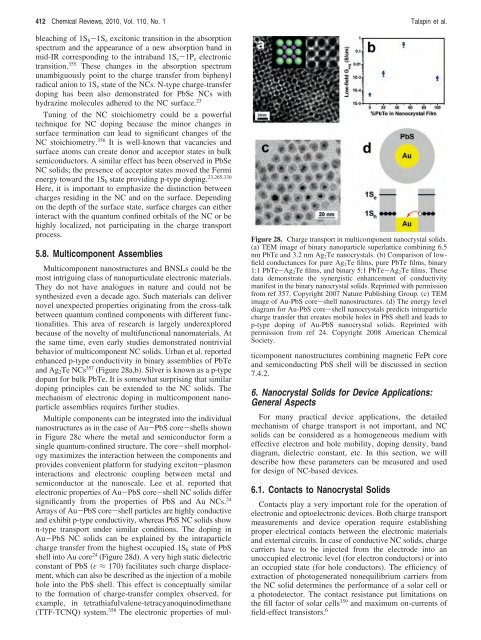Prospects of Colloidal Nanocrystals for Electronic - Computer Science
Prospects of Colloidal Nanocrystals for Electronic - Computer Science
Prospects of Colloidal Nanocrystals for Electronic - Computer Science
Create successful ePaper yourself
Turn your PDF publications into a flip-book with our unique Google optimized e-Paper software.
412 Chemical Reviews, 2010, Vol. 110, No. 1 Talapin et al.<br />
bleaching <strong>of</strong> 1Sh-1Se excitonic transition in the absorption<br />
spectrum and the appearance <strong>of</strong> a new absorption band in<br />
mid-IR corresponding to the intraband 1Se-1Pe electronic<br />
transition. 355 These changes in the absorption spectrum<br />
unambiguously point to the charge transfer from biphenyl<br />
radical anion to 1Se state <strong>of</strong> the NCs. N-type charge-transfer<br />
doping has been also demonstrated <strong>for</strong> PbSe NCs with<br />
hydrazine molecules adhered to the NC surface. 23<br />
Tuning <strong>of</strong> the NC stoichiometry could be a powerful<br />
technique <strong>for</strong> NC doping because the minor changes in<br />
surface termination can lead to significant changes <strong>of</strong> the<br />
NC stoichiometry. 356 It is well-known that vacancies and<br />
surface atoms can create donor and acceptor states in bulk<br />
semiconductors. A similar effect has been observed in PbSe<br />
NC solids; the presence <strong>of</strong> acceptor states moved the Fermi<br />
energy toward the 1Sh state providing p-type doping. 23,265,330<br />
Here, it is important to emphasize the distinction between<br />
charges residing in the NC and on the surface. Depending<br />
on the depth <strong>of</strong> the surface state, surface charges can either<br />
interact with the quantum confined orbitals <strong>of</strong> the NC or be<br />
highly localized, not participating in the charge transport<br />
process.<br />
5.8. Multicomponent Assemblies<br />
Multicomponent nanostructures and BNSLs could be the<br />
most intriguing class <strong>of</strong> nanoparticulate electronic materials.<br />
They do not have analogues in nature and could not be<br />
synthesized even a decade ago. Such materials can deliver<br />
novel unexpected properties originating from the cross-talk<br />
between quantum confined components with different functionalities.<br />
This area <strong>of</strong> research is largely underexplored<br />
because <strong>of</strong> the novelty <strong>of</strong> multifunctional nanomaterials. At<br />
the same time, even early studies demonstrated nontrivial<br />
behavior <strong>of</strong> multicomponent NC solids. Urban et al. reported<br />
enhanced p-type conductivity in binary assemblies <strong>of</strong> PbTe<br />
and Ag2Te NCs 357 (Figure 28a,b). Silver is known as a p-type<br />
dopant <strong>for</strong> bulk PbTe. It is somewhat surprising that similar<br />
doping principles can be extended to the NC solids. The<br />
mechanism <strong>of</strong> electronic doping in multicomponent nanoparticle<br />
assemblies requires further studies.<br />
Multiple components can be integrated into the individual<br />
nanostructures as in the case <strong>of</strong> Au-PbS core-shells shown<br />
in Figure 28c where the metal and semiconductor <strong>for</strong>m a<br />
single quantum-confined structure. The core-shell morphology<br />
maximizes the interaction between the components and<br />
provides convenient plat<strong>for</strong>m <strong>for</strong> studying exciton-plasmon<br />
interactions and electronic coupling between metal and<br />
semiconductor at the nanoscale. Lee et al. reported that<br />
electronic properties <strong>of</strong> Au-PbS core-shell NC solids differ<br />
significantly from the properties <strong>of</strong> PbS and Au NCs. 24<br />
Arrays <strong>of</strong> Au-PbS core-shell particles are highly conductive<br />
and exhibit p-type conductivity, whereas PbS NC solids show<br />
n-type transport under similar conditions. The doping in<br />
Au-PbS NC solids can be explained by the intraparticle<br />
charge transfer from the highest occupied 1Sh state <strong>of</strong> PbS<br />
shell into Au core 24 (Figure 28d). A very high static dielectric<br />
constant <strong>of</strong> PbS (ε ≈ 170) facilitates such charge displacement,<br />
which can also be described as the injection <strong>of</strong> a mobile<br />
hole into the PbS shell. This effect is conceptually similar<br />
to the <strong>for</strong>mation <strong>of</strong> charge-transfer complex observed, <strong>for</strong><br />
example, in tetrathiafulvalene-tetracyanoquinodimethane<br />
(TTF-TCNQ) system. 358 The electronic properties <strong>of</strong> mul-<br />
Figure 28. Charge transport in multicomponent nanocrystal solids.<br />
(a) TEM image <strong>of</strong> binary nanoparticle superlattice combining 6.5<br />
nm PbTe and 3.2 nm Ag2Te nanocrystals. (b) Comparison <strong>of</strong> lowfield<br />
conductances <strong>for</strong> pure Ag2Te films, pure PbTe films, binary<br />
1:1 PbTe-Ag2Te films, and binary 5:1 PbTe-Ag2Te films. These<br />
data demonstrate the synergistic enhancement <strong>of</strong> conductivity<br />
manifest in the binary nanocrystal solids. Reprinted with permission<br />
from ref 357. Copyright 2007 Nature Publishing Group. (c) TEM<br />
image <strong>of</strong> Au-PbS core-shell nanostructures. (d) The energy level<br />
diagram <strong>for</strong> Au-PbS core-shell nanocrystals predicts intraparticle<br />
charge transfer that creates mobile holes in PbS shell and leads to<br />
p-type doping <strong>of</strong> Au-PbS nanocrystal solids. Reprinted with<br />
permission from ref 24. Copyright 2008 American Chemical<br />
Society.<br />
ticomponent nanostructures combining magnetic FePt core<br />
and semiconducting PbS shell will be discussed in section<br />
7.4.2.<br />
6. Nanocrystal Solids <strong>for</strong> Device Applications:<br />
General Aspects<br />
For many practical device applications, the detailed<br />
mechanism <strong>of</strong> charge transport is not important, and NC<br />
solids can be considered as a homogeneous medium with<br />
effective electron and hole mobility, doping density, band<br />
diagram, dielectric constant, etc. In this section, we will<br />
describe how these parameters can be measured and used<br />
<strong>for</strong> design <strong>of</strong> NC-based devices.<br />
6.1. Contacts to Nanocrystal Solids<br />
Contacts play a very important role <strong>for</strong> the operation <strong>of</strong><br />
electronic and optoelectronic devices. Both charge transport<br />
measurements and device operation require establishing<br />
proper electrical contacts between the electronic materials<br />
and external circuits. In case <strong>of</strong> conductive NC solids, charge<br />
carriers have to be injected from the electrode into an<br />
unoccupied electronic level (<strong>for</strong> electron conductors) or into<br />
an occupied state (<strong>for</strong> hole conductors). The efficiency <strong>of</strong><br />
extraction <strong>of</strong> photogenerated nonequilibrium carriers from<br />
the NC solid determines the per<strong>for</strong>mance <strong>of</strong> a solar cell or<br />
a photodetector. The contact resistance put limitations on<br />
the fill factor <strong>of</strong> solar cells359 and maximum on-currents <strong>of</strong><br />
field-effect transistors. 6
















